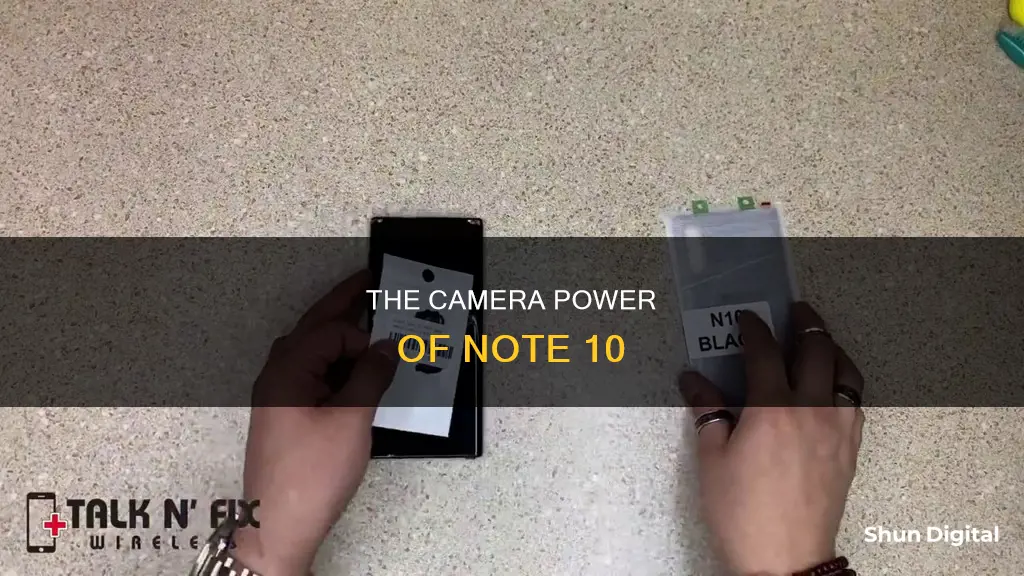
The Samsung Galaxy Note 10 is a line of Android-based phablets designed, developed, produced, and marketed by Samsung Electronics. The Galaxy Note 10 line comprises two models with various hardware specifications. The Note 10 and Note 10+ feature a multi-lens rear-facing camera setup with Samsung's Scene Optimizer technology. The rear camera setup includes a dual-aperture 12-megapixel wide-angle lens, a 12-megapixel telephoto lens, and a 16-megapixel ultra-wide-angle lens. The Note 10+ 5G model also includes an additional VGA Depth Vision Camera for 3D AR mapping.
| Characteristics | Values |
|---|---|
| Number of camera lenses | 3 rear-facing camera lenses, 1 front-facing camera lens |
| Rear-facing camera lenses | 12-megapixel wide-angle lens, 12-megapixel telephoto lens, 16-megapixel ultra-wide-angle lens |
| Front-facing camera lens | 10-megapixel punch hole lens |
| Camera software | "Shot Suggestion", "Artistic Live Filters", direct posting to Instagram, "Scene Optimizer" |
| Video recording | 4K/60 FPS, HDR10+, advanced video stabilization |
What You'll Learn
- The Samsung Galaxy Note 10+ has a 10-megapixel, f/2.2 aperture, auto-focus selfie camera
- The rear camera setup includes a 12-megapixel variable aperture lens
- There is also a 12-megapixel f/2.1 telephoto lens
- The ultra-wide lens is 16-megapixel with an f/2.2 aperture
- The camera has a time-of-flight sensor and an LED flash

The Samsung Galaxy Note 10+ has a 10-megapixel, f/2.2 aperture, auto-focus selfie camera
The 10-megapixel resolution of the selfie camera provides a good balance between image quality and file size. It strikes a nice compromise, ensuring that your photos have enough detail without taking up too much storage space on your device. The f/2.2 aperture setting is ideal for letting in the right amount of light to create well-exposed images. This aperture setting works well in most lighting conditions, from bright outdoor environments to low-light indoor scenes.
The auto-focus feature of the selfie camera is a significant advantage, especially when taking selfies. It ensures that your face remains in focus, even if you're holding the phone at arm's length. This feature is essential for capturing clear and sharp self-portraits, as it automatically adjusts the focus to ensure your face is the main subject of the image.
The combination of the 10-megapixel resolution, f/2.2 aperture, and auto-focus capabilities makes the Samsung Galaxy Note 10+ an excellent choice for anyone looking for a smartphone with a great selfie camera. It provides a good balance of image quality, lighting, and focus, resulting in flattering and share-worthy selfies. The camera is easy to use and delivers consistent results, making it a popular choice for those who want to capture special moments with family and friends.
Additionally, the Samsung Galaxy Note 10+ offers a range of other camera features that enhance your photography experience. It has a multi-lens rear-facing camera setup, including a 12-megapixel wide-angle lens, a 12-megapixel telephoto lens, and a 16-megapixel ultra-wide-angle lens. The Note 10+ also introduces an additional VGA Depth Vision Camera for 3D AR mapping, taking your photography and videography capabilities to the next level.
The Evolution of Camera Lenses: 8 to 10 mm Range
You may want to see also

The rear camera setup includes a 12-megapixel variable aperture lens
The Samsung Galaxy Note 10 is equipped with a multi-lens rear-facing camera setup. The rear camera setup includes a 12-megapixel variable aperture lens, which serves as the device's main lens. This lens features a variable aperture of f/1.5-2.4, allowing for excellent low-light performance and a shallow depth of field for portrait photography. The variable aperture gives users greater control over the amount of light entering the lens, resulting in more creative possibilities and improved image quality.
The 12-megapixel lens on the Samsung Galaxy Note 10 is a wide-angle lens, which means it has a wider field of view than a standard lens. This allows users to capture more of the scene in front of them, making it ideal for landscape and architectural photography. The wide-angle lens also enables users to get closer to their subjects without having to move physically, making it useful for street and documentary photography.
The variable aperture on the 12-megapixel lens also enhances the camera's performance in low-light conditions. With a maximum aperture of f/1.5, the lens can capture more light, resulting in brighter and clearer images in dimly lit environments. This feature is particularly useful for photographers who often shoot in low-light settings, such as event and wedding photographers.
In addition to the wide-angle lens, the rear camera setup of the Samsung Galaxy Note 10 also includes a 12-megapixel telephoto lens and a 16-megapixel ultra-wide-angle lens. The telephoto lens provides a 2x optical zoom, allowing users to get closer to distant subjects without losing image quality. On the other hand, the ultra-wide-angle lens offers a unique perspective and a broader field of view, making it perfect for capturing vast landscapes or tight indoor spaces.
The combination of these lenses in the rear camera setup of the Samsung Galaxy Note 10 provides users with a versatile photography experience. With the ability to switch between different lenses, users can easily adapt to various photography scenarios and capture stunning images in any situation. The 12-megapixel variable aperture lens, in particular, is a powerful tool that contributes to the overall excellence of the device's camera system.
Interchangeable Lenses: Mirrorless Camera Flexibility Explored
You may want to see also

There is also a 12-megapixel f/2.1 telephoto lens
The Samsung Galaxy Note 10 Plus has three camera lenses on the back of the device. One of these is a 12-megapixel f/2.1 telephoto lens, which offers a 2x optical zoom. This is joined by a 12-megapixel variable aperture (between f/1.5 and f/2.4) main lens with optical image stabilisation, and a 16-megapixel f/2.2 ultra-wide lens.
The telephoto lens is a great feature for photographers, as it allows you to get closer to your subject without physically moving. It's perfect for capturing shots that require a bit of extra reach, such as wildlife photography or sports events. With a 2x optical zoom, you can get crisp, clear images without the distortion or noise that often comes with digital zoom. The telephoto lens also has optical image stabilisation (OIS), which helps to reduce blur and improve image quality, especially in low-light conditions. This feature is particularly useful for night-time or indoor photography, where lighting may be less than optimal.
The 12-megapixel sensor on the telephoto lens provides excellent image quality, with sharp details and vibrant colours. The f/2.1 aperture allows for a good amount of light to enter the lens, resulting in bright and well-exposed images. This lens also has phase-detection autofocus (PDAF), which ensures fast and accurate focusing, so you can capture clear images even in fast-paced situations.
The telephoto lens on the Samsung Galaxy Note 10 Plus offers a lot of versatility and is perfect for photographers who want to capture a wide range of subjects and scenes. It's a great choice for anyone looking for a powerful and feature-rich smartphone camera.
Pentax Lenses: Will They Fit Your New Camera?
You may want to see also

The ultra-wide lens is 16-megapixel with an f/2.2 aperture
The Samsung Galaxy Note 10 features a multi-lens rear-facing camera setup. One of the lenses is an ultra-wide lens that is 16-megapixel with an f/2.2 aperture. This lens allows for a greater field of view, providing a unique perspective on scenes and enabling users to capture more of the scene in front of them.
The ultra-wide lens on the Samsung Galaxy Note 10 has a fixed aperture of f/2.2. Aperture refers to the opening in the lens that allows light to pass through to the image sensor. The size of the aperture affects the amount of light that enters the lens, as well as the depth of field (the area of the image that appears to be in focus). A wider aperture, denoted by a lower f-number, allows more light to enter the lens and creates a shallower depth of field, resulting in a softer background blur.
The f/2.2 aperture on the ultra-wide lens of the Samsung Galaxy Note 10 is relatively wide, allowing for a good amount of light to enter the lens. This can be particularly useful in low-light conditions, as it enables the camera to capture brighter images with faster shutter speeds. However, compared to the main lens of the Note 10, which has a variable aperture of f/1.5-2.4, the ultra-wide lens has a slightly narrower aperture. This means that the main lens can capture even more light when set to f/1.5, resulting in brighter images or faster shutter speeds.
The 16-megapixel resolution of the ultra-wide lens on the Samsung Galaxy Note 10 refers to the number of pixels that the lens can capture. A pixel is the smallest element of an image, and the more pixels there are, the higher the resolution and the sharper the image. With 16 million pixels, the ultra-wide lens is capable of capturing highly detailed images. This high resolution is particularly beneficial when using the ultra-wide lens for landscape or architectural photography, as it allows for large prints or cropping without losing image quality.
The combination of the f/2.2 aperture and 16-megapixel resolution on the ultra-wide lens of the Samsung Galaxy Note 10 results in a versatile camera that performs well in a variety of lighting conditions. The wide aperture allows for sufficient light intake, while the high resolution ensures that the captured images are sharp and detailed. This makes the ultra-wide lens on the Note 10 ideal for a range of photography applications, from low-light scenes to wide-angle landscape shots.
Why Are Camera Lenses So Affordable?
You may want to see also

The camera has a time-of-flight sensor and an LED flash
The camera on the back of the Samsung Galaxy Note 10 Plus has three lenses: a 12-megapixel variable aperture main lens, a 12-megapixel telephoto lens, and a 16-megapixel ultra-wide lens. In addition to these three lenses, the camera also features a time-of-flight (ToF) sensor and an LED flash.
The ToF sensor is a dedicated sensor for depth estimation in Portrait mode. It helps to create a pleasant blur effect, known as the bokeh effect, and delivers generally very good results in this mode. The ToF sensor is part of the quad-camera setup on the Note 10 Plus, which also includes the primary, ultra-wide, and telephoto lenses.
The LED flash on the Note 10 Plus is also worth mentioning. It performs well in low-light conditions, with the device being one of the best in its class for night photography. The flash helps to capture excellent images, with good exposure and detail, even in challenging lighting situations.
The combination of the time-of-flight sensor and the LED flash enhances the camera capabilities of the Note 10 Plus, allowing for improved performance in various shooting scenarios. These additional features complement the three lenses, resulting in a versatile and capable camera system.
Camera Lenses: Retaining Value Over Time?
You may want to see also
Frequently asked questions
The Samsung Galaxy Note 10 has a multi-lens rear-facing camera setup with three lenses: a 12-megapixel wide-angle lens, a 12-megapixel telephoto lens, and a 16-megapixel ultra-wide-angle lens.
The Samsung Galaxy Note 10 Plus has four camera lenses on the back. In addition to the three lenses on the standard model, the Plus model has an extra VGA Depth Vision Camera, enabling 3D AR mapping.
The standard Samsung Galaxy Note 10 has three camera lenses, while the Plus model has one additional lens, providing enhanced features such as 3D AR mapping.







